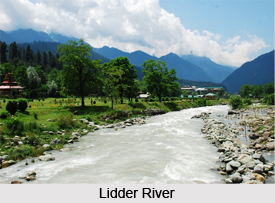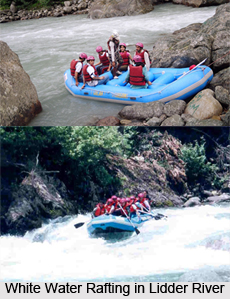 Lidder River is a 73 km long river in the Kashmir region of India in the state of Jammu and Kashmir. It originates from the Kolhoi Glacier of the Jhelum River and meets it at Gurnar Khanabal village at an altitude of 1615 meters.
Lidder River is a 73 km long river in the Kashmir region of India in the state of Jammu and Kashmir. It originates from the Kolhoi Glacier of the Jhelum River and meets it at Gurnar Khanabal village at an altitude of 1615 meters.
Geography of Lidder River
Lidder River that gives rise to Lidder Valley originates from Kolhoi Glacier in the vicinity of Sonmarg and runs southwards through an alpine meadow called Lidderwat in region of Pahalgam Aru, from which the river has got its name. The river flows through lush green mountains of fir. The tourist village Aru is situated on its bank. It covers 30 km to the tourist destination of Pahalgam where it meets a major tributary (the East Lidder) from Sheshnag Lake and runs westwards until it meets the Jhelum River at Gurnar Khanabal village of Anantnag. The colour of the water of the river is crystal blue as of Neelum River. Pahalgam occupies the central Lidder Valley.
Course
Lidder River gives rise to Lidder glaciers. It mainly originates from Kolhoi glacier where it meets Gurnar Khanabal village situated at the height of 1615km. The river flows via lush green peaks of fir and runs south wards via Lidderwat.
Tributaries
Sindh River and Neelum River are the major tributaries of Lidder River. It is one of the important tributaries of the Indus River.
 Lidder River for Irrigation
Lidder River for Irrigation
The water of Lidder River is majorly used for irrigation purpose with the help of various canals. The most famous canal amongst them is "Shah Kol". The water of the river is also used for drinking purpose after going through numbers of water treatment plants. There are various kinds of fishes present in the water of river. In fact certain fisheries plants have also been built at the side of the river. Some of the most commonly found fishes in the water of Lidder River are:
•Rainbow Trout,
•Brown Trout
•Anyour
•Shuddgurn
The waters of the river are mainly used for irrigation purpose through different canals; the famous among them is Shah Kol and drinking through water treatment plants.
Activities on Lidder River
The river flows through the scenic town of Pahalgam and is one of the important attractions of the region. This is the river which is best suited for river rafting and trout fishing activities. White water rafting on the waters of Lidder River is must do thing when in Pahalgam. Adventurous tourists visit the place not only to indulge in these activities but also to feast their eyes with the unparalleled beauty of the Lidder Valley. Lidder River is the main source of water for Anantnag and its nearby areas. The beautiful Lidder Valley from which the river derives its name adds to the scenic beauty as the peaceful environs of the valley rejuvenate ones tired mind, body and soul.















